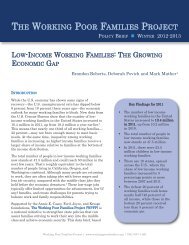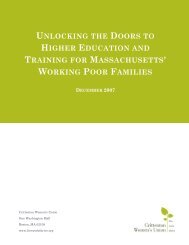alabama's working families and the broken promise of economic ...
alabama's working families and the broken promise of economic ...
alabama's working families and the broken promise of economic ...
- No tags were found...
Create successful ePaper yourself
Turn your PDF publications into a flip-book with our unique Google optimized e-Paper software.
CHAPTER 3The Employment GapAlabama’s growing economy may appear at first glance to be meeting <strong>the</strong>employment needs <strong>of</strong> <strong>the</strong> state’s citizens, but a closer look reveals gaps –with many Alabamians not participating in that growth. A July 2007 reportby <strong>the</strong> Wachovia Economics Group referred to Alabama’s “quiet <strong>economic</strong>boom,” in which <strong>the</strong> state’s gross domestic product grew 3.2 percent over<strong>the</strong> previous year while <strong>the</strong> national economy grewby just 1.9 percent. 44 For most <strong>of</strong> <strong>the</strong> last decade,Alabama’s unemployment rate has been significantlyless than <strong>the</strong> national rate. One would expectthat this strong employment record <strong>and</strong> robusteconomy would be reflected in <strong>the</strong> pocketbooks <strong>of</strong>Alabama’s workers, but during <strong>the</strong> period 2000-01to 2004-05, <strong>the</strong> median household income (inadjusted dollars) actually fell 5 percent, from $39,465to $37,502. 45 And despite that record low unemploymentrate, Alabama’s labor force participation rateranked 44th among states. 46Even though news <strong>of</strong> successful major industrialrecruitment efforts fills <strong>the</strong> airwaves, <strong>the</strong> resultinggrowth in jobs conceals a corresponding growth in<strong>the</strong> wage gap. Alabama’s economy is increasinglyreliant on service-sector employment – such ashotel <strong>and</strong> restaurant work, retail sales <strong>and</strong> clericalsupport – which traditionally <strong>of</strong>fers lower wagesthan o<strong>the</strong>r sectors. The occupational sector that isexpected to see <strong>the</strong> highest number <strong>of</strong> jobs createdduring <strong>the</strong> next 10 years is <strong>of</strong>fice <strong>and</strong> administrativesupport occupations. 47In 2005, occupations that generally pay below 200 percent<strong>of</strong> <strong>the</strong> poverty level accounted for 79.4 percent<strong>of</strong> all jobs in Alabama. 48 The Alabama Department<strong>of</strong> Industrial Relations projects that employers in <strong>the</strong>state will add 299,360 new jobs between 2004 <strong>and</strong>2014, but <strong>the</strong> greatest growth will come in low-wagesectors. 49 The table on Page 28 reflects <strong>the</strong> top fiveoccupations in terms <strong>of</strong> projected job growth through2014. With <strong>the</strong> exception <strong>of</strong> registered nurses, none<strong>of</strong> <strong>the</strong>se growth occupations comes near providingan income equal to 200 percent <strong>of</strong> <strong>the</strong> poverty level.These lower-income jobs frequently require only ahigh school degree or less <strong>and</strong> provide low wages <strong>and</strong>few benefits. As <strong>the</strong>se jobs proliferate, <strong>working</strong> <strong>families</strong>will face challenges in achieving self-sufficiency,no matter how hard <strong>the</strong>y work.More than 2.1 million people over <strong>the</strong> age <strong>of</strong> 16make up Alabama’s workforce. The overall laborforce participation rate – <strong>the</strong> percentage <strong>of</strong> <strong>the</strong>population over <strong>the</strong> age <strong>of</strong> 16 who are <strong>working</strong>or actively looking for work – was 62.5 percent,slightly below <strong>the</strong> national average <strong>of</strong> 66 percent.To make ends meet, almost 95,000 workers inAlabama hold more than one job. Alabama workersstrive hard each day to provide for <strong>the</strong>mselves<strong>and</strong> <strong>the</strong>ir <strong>families</strong> <strong>and</strong> to better <strong>the</strong>ir communities.But individual advancement in today’s economyrequires more than just individual effort. In promotingjob creation, state policymakers have takena largely quantitative approach, ra<strong>the</strong>r than defininggoals that would <strong>of</strong>fer low-income workersmore opportunities to establish <strong>economic</strong> security<strong>and</strong> improve <strong>the</strong>ir <strong>families</strong>’ well-being.The gap in job creationAlabama has seen striking success in <strong>the</strong> use <strong>of</strong><strong>economic</strong> incentives <strong>and</strong> tax credits to generatelarge-scale employment opportunities. Beginningin 1993 with <strong>the</strong> announcement that Mercedes-Benzwould construct its first U.S. assembly facility inAlabama <strong>and</strong> continuing though <strong>the</strong> 2007 announcementthat German conglomerate ThyssenKruppAlabama’s Working Families 27







